
 |
|||||
|
|
|||||
|
|
|
|||||
|
|
VOYAGER A Hertfordshire apple raised in 1952, probably by A.R. King of Barnet, and having Laxton’s Superb as one parent. Sweet, crisp flesh, with a rich spicy flavour. Ripe in mid-October, and storing until the end of the year. Pollination Group 3 |
|||
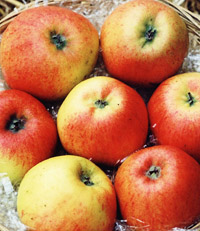 |
WADHURST PIPPIN Dating from the early 1800s, it is primarily a culinary apple, but it has also been considered a fair dessert apple and has been used for cider. It is believed to have originated at Wadhurst in Sussex. Scott and Hogg broadly describe it in the same way, though Scott makes no remark about red stripes, and Hogg does. The apple currently known as Wadhurst Pippin is liberally striped, on the sunny side, over a yellow skin. The apples are medium to large and conical, and ribbed on the body and at the eye. The flesh is juicy, crisp, yellowish and acid. Ripe from late October and storing until January. Pollination Group 5 |
|||
 |
WAGENER
An excellent apple from America. It was grown from seed planted at Penn
Yan, New York, in 1791, by a nurseryman called Wheeler. His nursery was
subsequently bought by Abraham Wagener, who introduced the apple commercially
in the mid nineteenth century in America, when it won a prize and become
very well known. Thomas Rivers’ nursery, in Hertfordshire, introduced
it to England in the second half of the 19th century. It became popular
for its crisp, sweet, juicy fruit, which could be used for dessert or
cooking. Stores very well, until April. Pollination Group 2 |
|||
 |
WALTHAM
ABBEY SEEDLING Raised in 1810 by John Barnard at Waltham Abbey.
Hogg says it was produced from a seed of Golden Noble while Bunyard says
a seed of Holland Pippin. A medium to large cooking apple, which is also
sweet enough to be eaten raw when fully ripe in October. The apples contain
very little acid. Cooked, it keeps its shape and needs no sugar added.
It has been said to keep to December, but the flavour deteriorates by
then. Pollination Group 4 |
|||
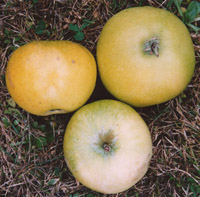 |
WARDINGTON
SEEDLING Raised by D. Burchnall, gardener to Lady Wardington,
at the village of Wardington, near Banbury, Oxfordshire. It first fruited
in 1938. It was a seedling of Cox’s Orange Pippin. The medium sized
apples are flattened conic, slightly ribbed at the eye and yellowish green
with occasional pink stripes. A middle season dessert apple, that deserves
to be near the top of the ‘best dessert apples’ list. Ripe
in mid September it is crisp, fine-fleshed, very juicy, sweet, rich and
tangy with a hint of pears. By November, it starts to shrink but is still
very good, juicy and with a sweet, lemony flavour. Pollination Group 3 |
|||
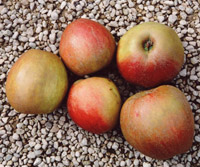 |
WARDROBES
HOUSE A very good old apple, in the small domestic orchard attached
to Wardrobes House, in the Buckinghamshire Chilterns. We were informed
of the fruit trees at Wardrobes House when Andrew Freeman, a tree surgeon
and keen naturalist undertook some work there. The owners, Tara and Carl
Leaver, kindly allowed us to research their trees and have provided much
useful information about the House and its history. It is very close to
the Tudor ‘Bradenham Manor’. It seems that the unusual name
comes from the noble appointment of ‘Keeper of the Wardrobe’
dating from the time of Henry VIII or before and having little to do with
clothes, and much to do with royal accounts. Lord Andrew Windsor, Lord
of the Manor of Bradenham was the ‘Keeper of the Wardrobe’
to Henry VIII. His son built Bradenham Manor house. Another thread suggests
that the name might denote a place where estate income was due to the
Royal ‘Wardrobe’. One might still expect that Lord Windsor
would have lived very close to Bradenham, yet no house is known. Interestingly,
as Tara pointed out to us, there is a ‘Windsor Hill’ very
close to them. The current Wardrobes House has a 16th century chimney
and 17th century parts, but any earlier history is unknown. There was
once a ‘Little Wardrobes’ and a Wardrobes Farm still exists.
The known history of the current house says that it was built as the main
dwelling for Wardrobes Farm. The location of Lord Windsor’s dwelling
remains unknown. It would be pleasing to think that the trees in the orchard
have been re-propagated and passed down from his times. The apple, now
called Wardobes House is dual purpose. It is conical, sometimes a little
longer than wide, pale green underneath with thin veins of russet and
brown red showing through and with rich crimson on the cheek. It is crisp
and fairly juicy, with a sweet and tangy flavour. Ripe in late September,
it will keep until December, but tends to shrink a bit. Pollination Group
4 |
|||
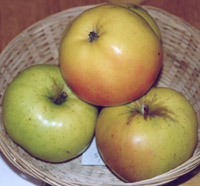 |
WARNER'S KING Killick's Apple, King Apple. It is said to have come from a tree in Maidstone, and was known in Kent in the 18th century as the King Apple. Mr Warner sent it to the famous Hertfordshire nurseryman Thomas Rivers, who named it Warner's King and introduced it. This very large culinary apple was a favourite with the Victorians, valued for its rich flavour. When cooked, it keeps its shape and is rather sharp and in need of some sugar. Decorative and vigorous trees, with dark leaves, good blossom and good crops. Ready to pick in September, and stores until December. The size of the fruit makes it unsuitable for espaliers and cordons. T. Pollination Group 2 | |||
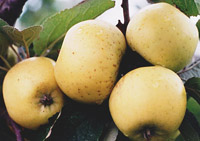 |
WAX
APPLE Said to be a Sussex apple, first recorded in 1826 and seemingly
lost for a long while. An old and attractive apple about which little
is known. The flattish, elegant golden apples have a waxy flecked skin.
They are medium sized, firm, sweet and full of flavour. A late dessert
apple that keeps for a couple of months, at least. This does not appear
to be the same as the Wax Apple of the National Apple Register (1971),
which seems to confuse Wax Apple and Early Wax. It is possible that Wax
Apple is the same as the ancient Wachsapfel known in Germany with Diel
at the start of the 19th century and believed ‘lost’. Pollination
Group 4 |
|||
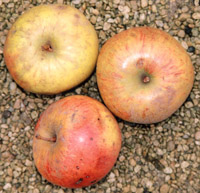 |
WELFORD
PARK NONSUCH Bred by Charles Ross, head gardener at Welford Park
near Newbury, Berkshire, the seed was sown in 1864 and it first fruited
in 1871. It was featured, with a colour plate, in the Herefordshire Pomona,
of 1876-85 and was also exhibited at the 1883 National Apple Congress.
It seems to have been lost for many decades, despite having had a high
reputation and we had been searching for it. In 2007, Suyin and Huw Powell
brought an apple to our attention, calling it Welford Park Nonsuch. Huw’s
mother was a friend of the owner of the tall and mature tree near Lugwardine
in Herefordshire. Suyin had given some apples to a friend Cathy Widdicombe.
Her ecologist and arboriculturist husband, Rob, had consulted a copy of
the Herefordshire Pomona and Hogg’s ‘Fruit Manual’.
He believed it might well be Welford Park Nonsuch from the plate and description.
We also received some fruit from Suyin and, though inclined to scepticism,
were compelled to the same conclusion. The descriptions by Hogg and Scott
match almost perfectly, but particularly in respect of the texture of
the flesh. It is a dual purpose apple, with an excellent aromatic flavour
and quite an attractive appearance, with pink/red and orange flushes and
stripes. The flesh is crisp but also very tender and fine. Dr Widdicombe
later informed us that the old tree was blown down a year after the scions
were taken. Pollination Group 4 |
|||
|
||||